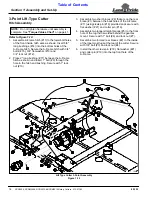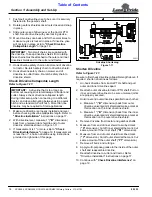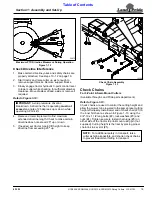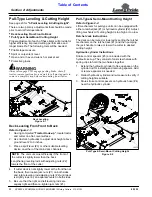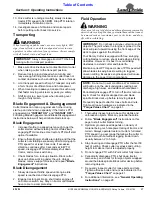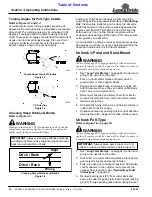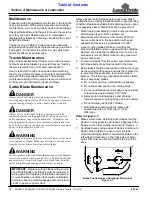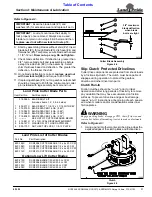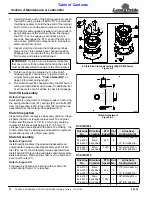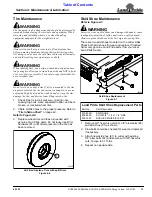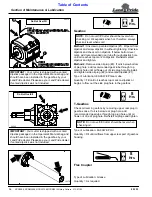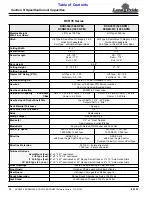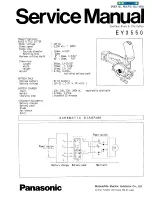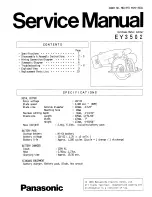
27
Section 3: Operating Instructions
8/15/12
RCR3596, RCRM3596, RCR3510 & RCRM3510 Rotary Cutters 312-517M
Table of Contents
13. Once cutter is running smoothly, slowly increase
tractor PTO speed to 540 RPM. Stop PTO rotation
immediately if vibration occurs.
14. Investigate cause of vibration and make repairs
before putting cutter back into service.
Transporting
!
WARNING
When traveling on public roads, use accessory lights, SMV
sign, clean reflectors, and other adequate devices to warn
operators in other vehicles of your presence. Always comply
with all federal, state, and local laws.
1.
Make sure driveline does not contact tractor or cutter
when raising cutter to the transport position.
2.
Reduce tractor ground speed when turning and
leave enough turning clearance so cutter does not
contact obstacles such as buildings, trees or fences.
3.
Limit transport speed to 20 mph. Transport only with
a farm tractor of sufficient size and horsepower.
4.
When traveling on roadways, transport in such a way
that faster moving vehicles may pass you safely.
5.
Shift tractor to a lower gear when traveling over
rough or hilly terrain.
Blade Engagement & Disengagement
Cutter blades can lock-up against each other during
start-up and shut-down especially if the tractor’s PTO
engagement is “INSTANT ON” and “INSTANT OFF”.
Following Blade Engagement and Blade Disengagement
instructions below will help eliminate blade lock up.
Blade Engagement
1.
Increase throttle to a speed just enough to get the
cutter started without stalling tractor while slowly
engaging PTO drivelines. Use tractor’s PTO soft start
option if available.
2.
Ensure that all power shafts are rotating and that the
cutter is not vibrating excessively after ramping up to
PTO speed for at least 3 seconds. If excessive
vibration continues after 3 seconds at full PTO
speed, disengage PTO immediately, shut down
tractor, and remove switch key.
3.
Check blades for a lock-up situation. Block cutter
deck up before working under the unit. Unlock
blades, remove support blocks, and repeat "Blade
Engagement" instructions.
Blade Disengagement
1.
Slowly decrease throttle speed until engine idle
speed is reached and then disengage PTO.
2.
Engage tractor park brake, shut tractor engine off
and remove switch key. Stay on tractor until blades
have come to a complete stop.
IMPORTANT: Always disengage tractor PTO before
raising cutter to transport position.
Field Operation
!
WARNING
Clear area to be cut of debris and other unforeseen removable
objects before cutting. Mark any potential hazards that cannot
be removed such as tree stumps, post, rocks, holes, and drop-
offs with a visible flag.
1.
Thoroughly inspect area to be cut for debris and
unforeseen objects. Mark any potential hazards.
2.
Follow "Blade Engagement" instructions on this
page to start cutter blades turning.
3.
Optimum ground speed depends on density of
material being cut, horsepower rating of tractor, and
terrain. Always operate tractor at cutter’s full rated
PTO speed in a gear range that allows the cutter to
make a smooth cut without lugging tractor down,
usually between 2 to 5 mph.
4.
Stop traveling and disengage PTO after the first 50
feet of cutting. Check cutter levelness and cutting
height to make certain it is adjusted properly.
5.
Do not engage PTO with 3-Point cutter fully raised.
6.
Periodically disengage PTO, shut down tractor,
remove key, and check for foreign objects wrapped
around the blade spindle. Block cutter deck up before
removing objects.
7.
Frequently inspect cutter for loose bolts and nuts.
Tighten all loose bolts and nuts as indicated in the
“Torque Values Chart” on page 41.
8.
For additional information, see “General Operating
Instructions” on page 29.
IMPORTANT: Do not back pull-type cutter into solid
objects. The joint where the tongue is pinned to the
deck will pivot upward causing the front edge of the
deck to press against the driveline.
Your Rotary Cutter is equipped with free swinging
cutting blades to reduce shock loads when striking
obstacles. However, it is best to avoid striking
obstacles to extend cutter and blade life.
Maintain correct PTO speed. Loss of PTO speed will
allow blades to swing back resulting in ragged,
uneven cutting. Excessive engine speed will cause
damage to the power train components.
NOTE: Do not cut in wet conditions. Wet material
will build up on the deck underside creating poor
discharge, high wear, and additional horsepower.
Periodically disengage PTO, turn off tractor, remove
key & check for objects wrapped around blade
spindle. Block deck up before removing objects.
Frequently inspect cutter for loose bolts and nuts.
Tighten all loose hardware as indicated in the
“Torque Values Chart” on page 41.




